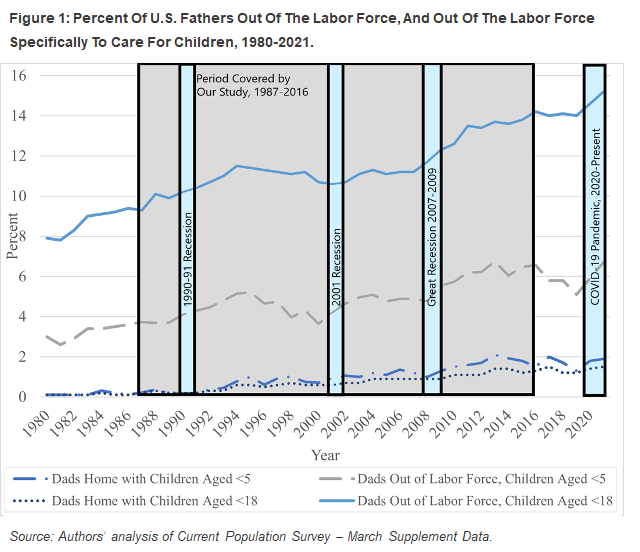
In 2021, the number of stay-at-home dads in the United States reached record highs. Does this mean that cultural views about gender, masculinity, work, and family—particularly the idea that men should be breadwinners—are changing? Not necessarily.
Our recent research in Gender & Society assesses cultural views of stay-at-home fathers over three decades, by examining their portrayal in leading newspapers and magazines between 1987 and 2016. We found that news portrayals of stay-at-home dads have indeed become more positive over time. But the growing support for full-time caregiver fathers is conditional.
Dads who lost their jobs because of involuntary unemployment are viewed sympathetically, especially since the Great Recession. But dads who are able to work, but choose to stay home with children instead, are still described negatively. As much as we’d like to think that the gender-bending phenomenon of (slightly) increasing numbers of dads at home is a harbinger of more fundamental gender liberalization, our results suggest that this is not unambiguously the case.
News articles about stay-at-home dads often focused on the stigma and hardships that these dads faced in their everyday lives. In the 94 articles we analyzed, stay-at-home dads discussed being laughed at, dismissed, or even accused of being a pedophile while at the playground with their child. They were often described as being shunned by mothers and ridiculed by their friends. Fathers discussed feeling like “less of a man” because they could not financially provide for their families, and over half were described as feeling isolated and experiencing stress because of their role. Many recounted being called “Mr. Mom”, the title of a 1980s movie about an inept stay-at-home dad. This phrase reinforced the idea that active parenting was something that women do, not men. Further reinforcing this idea, some dads were instead excessively praised for doing the most basic chores with their child (like bringing them to the grocery store).
But the focus on stigma lessened over time, as more dads began to stay home with children. After the Great Recession resulted in high rates of unemployment, dads who had lost their jobs and took on caretaking roles at home were no longer described as experiencing stigma, and were discussed sympathetically and supportively. Accounts of stigma experiences didn’t disappear, however; instead they were mostly confined to another type of stay-at-home dad—those who had chosen to stay home with their children, and hadn’t been forced into the role by lay-offs.
In our article we also compared stay-at-home dads’ depictions to demographic trends. In the figure below, we extend this analysis to 2021 to include another major economic shock—the COVID pandemic. What is clear is that the rate at which fathers were at home rose in the wake of economic downturns, but eventually reversed course and reverted to near pre-downturn levels upon economic recovery. Over the period we studied, staying home became more common among dads—especially after the Great Recession of 2007-9. But the number of dads who reported they were home specifically to take care of children was still very low—less than two percent in 2021. And prior to the pandemic, rates of staying home had begun to go down among dads of younger children, declining almost to pre-Great Recession levels by 2019. These patterns also suggest that the post-recession increase in dads staying home was not a result of long-lasting changes in attitudes and ideologies about gender and work, but rather was a temporary response to economic precarity.

Taken together, our findings indicate that cultural views on stay-at-home dads may be changing, but mostly for dads who stay home because they don’t have any other choice. The stigma about stay-at-home dads has been reduced, but only because more dads are out of the workforce because of broader economic circumstances that make it impossible for them to be breadwinners. Dads who choose to stay home and not contribute financially to the family are still stigmatized, presumably seen as failures as breadwinners or as deadbeats for ducking this responsibility entirely. But dads who began to stay home because of the pandemic (or other future economic events) are likely to be viewed sympathetically, suggesting some relaxing of strong male-breadwinner social norms.
And cultural views may continue to change. A recent report found that over 70% of mothers will spend at least part of their children’s childhood as the main financial provider, with the average mother spending 6 years in this role. The pandemic also reversed the beginning of a decline in staying home rates among fathers of young children, and dads are now out of the labor force and home with kids at record-high rates. The sustained rate of dads staying home with kids may reduce the stigma of this role even further, as more children grow up with dads at home as caregivers for at least some portion of their childhoods.
On the other hand, support for dads staying home may be reduced if economic conditions improve more broadly, reducing the number of men in that role involuntarily. And during the pandemic, while more dads withdrew from the labor force and increased the time they spent on housework and childcare, in 70% of families it was mothers who were primarily responsible for homeschooling when schools went virtual.
Mothers were also far more likely than fathers to withdraw from the workforce or reduce their hours in paid work. These pandemic trends also reinforce the idea that the recent uptick in dads staying home is not an auger of radical gender change, but that traditional ideas about gender and parenting and divisions of labor are still going strong. Until these ideas change, and the stigma of men voluntarily staying home with children is reduced, few men will be willing to take on this role, preventing advancement towards full gender equality in work and family roles.
This post was originally published at Gender & Society.

No Comments